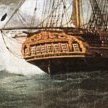-
Posts
6,365 -
Joined
-
Last visited
Reputation Activity
-
 wefalck got a reaction from Valeriy V in USS San Pablo 1920 by Ras Ambrioso - Scale 1/64 - River Gunboat
wefalck got a reaction from Valeriy V in USS San Pablo 1920 by Ras Ambrioso - Scale 1/64 - River Gunboat
Oops, missed the continuation of this new project ... have been travelling too much the last few weeks.
When I used very thin copper-sheet to simulate hull plating and pouncing the rivets, I found that rubbing them down from the front with a cork (Champagne corks work best, because of their round lower edges and sort of integrated handle) reduces the distortion of the sheet and gives a more realistic look. I have not tried the same with styrene sheet. Not sure that it would work, because it is less malleable than copper, but it may be worth a try.
Another material that I have used is this self-adhesive aluminium tape that is used to cover up the seams in dry-walling. However, I have used it only only represent rivetted reenforcement strips, not larger surfaces, as I am a bit weary of self-adhesive materials - the adhesive film might dry out and become brittle with time.
-
 wefalck reacted to Ras Ambrioso in USS San Pablo 1920 by Ras Ambrioso - Scale 1/64 - River Gunboat
wefalck reacted to Ras Ambrioso in USS San Pablo 1920 by Ras Ambrioso - Scale 1/64 - River Gunboat
After a couple of failures trying to keep the row of rivets straight, I came up with an idea for a tool to help. Using a metal ruler, a cutting board and a couple of bolts with wing nuts I came up with this baby.
This is like of the tool to bend etched parts. The results speak for themselves.
In using this tool I found that you have to keep the pounce wheel tight against the ruler with equal amount of pressure and make just one round. Another thing to remember is that the rivets are rolled in the back of the sheet so that the rivet shows up at the front.
Just wanted to share this with y'all.
-
 wefalck reacted to Ras Ambrioso in USS San Pablo 1920 by Ras Ambrioso - Scale 1/64 - River Gunboat
wefalck reacted to Ras Ambrioso in USS San Pablo 1920 by Ras Ambrioso - Scale 1/64 - River Gunboat
As I mentioned in a previous post, I changed the color of the planking in the main deck and the forecastle. Following is the before and after.
I think the planks are now more to scale and the color is more compatible with the boat's white paint. Also started the development of the riveted joints. The panel was cut out of basswood and, using O.O5" thick polystyrene (almost like heavy paper), I reproduced the panel's outline and openings. Then, using a pounce wheel, the rivets were punched from the backside thus producing a very realistic riveted line in the front.
The plastic sheet has not been glued to the panel and I will try to better locate the rivet lines. Also covered the fantail steering station with mosquito net painted black to simulate the tread plate surface.
Thanks for the comments and likes.
-
 wefalck reacted to Ras Ambrioso in USS San Pablo 1920 by Ras Ambrioso - Scale 1/64 - River Gunboat
wefalck reacted to Ras Ambrioso in USS San Pablo 1920 by Ras Ambrioso - Scale 1/64 - River Gunboat
Finally, I get some time to post some progress. I have been busy elsewhere and also fighting mistakes made at the beginning of this build. The hull has been a total nightmare as I had a difficult time fairing the frames and installing the planks . I tried to save time by using plain sheets of wood and then wider planks. The results were horrible.
Spent a lot of time filling and sanding.
Also installed the main deck planking.
But again, after looking at it for a while, I decided that the planks I selected were too wide: therefore I am in the process of replacing with smaller planks. Also I will change the color to a more subtle wood color.
As a distraction from the above mentioned troubles I started to work on the cabins. All of the cabins, with the exception of the rear top one, are rivetted steel. I have been looking at different methods for representing the rivets. On Keith advise's I ordered a sheet of Archer's transfer rivers at a cost of $17.95 per sheet. They look great but the sheets are only 3" by 5" and with the large amount of rivets required by this build it will be a very expensive detail.
I decided to make a wood panels of the cabins with their openings. Then then glue a very thin sheet of plastic on which I would have made the rivets using a pounce wheel.
First I had to make a mockup of the superstructure since the plans are difficult to understand and, unfortunately, I have found a few mistakes in them.
The mockup is not to scale but allows me look at the different levels in 3D. Followings the set up of an assembly jig and the first wall panels.
Thanks for your comments and likes.
-
 wefalck reacted to yvesvidal in USS San Pablo 1920 by Ras Ambrioso - Scale 1/64 - River Gunboat
wefalck reacted to yvesvidal in USS San Pablo 1920 by Ras Ambrioso - Scale 1/64 - River Gunboat
Ras, I hope I am not hijacking your thread with this post, but there is a modeler in Spain who has been building the San Pablo in the 1/35th scale:
https://www.ebay.com/itm/326240588162?itmmeta=01JMJ20BHNV76DFB5CNMDBBQCS&hash=item4bf5745182:g:ZyUAAOSwZupggtEC
It is a very impressive model and I thought that some of his pictures may help you. That Spanish gentleman is definitely the "Rey of the the Styrene sheets". I love his models.
Yves
-
 wefalck reacted to Ras Ambrioso in USS San Pablo 1920 by Ras Ambrioso - Scale 1/64 - River Gunboat
wefalck reacted to Ras Ambrioso in USS San Pablo 1920 by Ras Ambrioso - Scale 1/64 - River Gunboat
My next project has been on my “to do list “since I saw the movie The San Pebbles in 1966. The San Pablo represents one of the many gunboats that were used by the western nations to patrol the waters of the Yangtze River in China during the period of the Chinese wars between war lords, nationalists and communist’s factions. The movie involves a sailor in charge of the steam engine that powers the ship.
The USS San Pablo was a 150-foot steel-hulled gunboat, built by Vaughn & Yung Engineering Ltd. of Hong Kong.
There is a lot of information on the web about this ship and about the real US Navy ships that were used in this service such as the USS Panay that was bombed by the Japanese in 1939. Following are some links to sites on this subject.
https://industrialhistoryhk.org/sand-pebbles/
https://www.thesandpebbles.com/naval_history/real_sandpebbles1.htm
ttps://www.usni.org/magazines/naval-history-magazine/2000/february/real-sand-pebbles
As I said before, I had this project in mind for a long time but could not obtain proper plans. Finally ,last year, I found a link to a French magazine that included the plans for this gunboat. The plans were at 1/45 scale that made the boat 40” long so I had the plans reduced to 1/64 scale with a length of a little more than 28 inches.
I decided to build as plank on frame method used MDF boards for the spine and frames but the material I found was 1/4” thick and the resulting ship skeleton looks very heavy, but it will provide plenty of surface for the planking. Following is the progress to date.
Developing the frames pieces
Starting the framework.
The first long plank.
Then, the development of the conical shape and using a wood mold to bend the wood pieces that will form the aft bulkwark will come next
-
 wefalck got a reaction from JacquesCousteau in Bateau de Lanvéoc by JacquesCousteau - Scale 1:32 - From Ancre Plans
wefalck got a reaction from JacquesCousteau in Bateau de Lanvéoc by JacquesCousteau - Scale 1:32 - From Ancre Plans
Perhaps you could use cardboard-templates to work out the geometry?
-
 wefalck got a reaction from FriedClams in Lancha Chilota by JacquesCousteau – Scale 1:32 – Chilean Coasting Sloop
wefalck got a reaction from FriedClams in Lancha Chilota by JacquesCousteau – Scale 1:32 – Chilean Coasting Sloop
I had discovered decades ago that making half-hitches eases the seizing of blocks etc. a lot and keeps the rounds in place. The only issue is that one can see this on one side, so strategic placing of the 'hitch' to become mostly not visible is a good idea.
If you are averse to using an organic solvent-based varnish (e.g. diluted clear nail varnish) for securing rigging, you may want to try the cement they use in nail-studios to stick artificial nails to ladies' real nails. I recently discovered that this is a mixture of CA and metacrylic monomers: it sticks quite fast, but you have several minutes to adjust things before it fully cures. It is not as 'nasty' as pure CA and forms strong bonds. It should be readily available in your part of the world.
-
 wefalck got a reaction from FriedClams in Lancha Chilota by JacquesCousteau – Scale 1:32 – Chilean Coasting Sloop
wefalck got a reaction from FriedClams in Lancha Chilota by JacquesCousteau – Scale 1:32 – Chilean Coasting Sloop
When there are eye-bolts, blocks would be shackled or hooked to them. The blocks would be either internally stropped in metal, or there would be an external strop in rope with an eye for the shackle/hook. The splice or the whole strop could be served and there would be a seizing between the block and the eyelet.
I suspect that on a boat like this there may be a few windings of wire replacing the shackle …
-
 wefalck got a reaction from Harvey Golden in Pomeranian Rahschlup 1846 by wefalck – 1/160 scale – single-masted Baltic trading vessel
wefalck got a reaction from Harvey Golden in Pomeranian Rahschlup 1846 by wefalck – 1/160 scale – single-masted Baltic trading vessel
Thanks for the 'likes' !
***********************
Fitting the rails
The rails are 0.75 mm x 1.50 mm styrene strips on top of the bulwark and a 0.75 mm x 2.00 mm strip over the stern. The edges of the strips are rounded.
To this end I cut a scraper from a piece of razor-blade which is held in a short pin-vice. The strip is held in a simple jig made from cardboard. Strips of cardboard were cut with clean and vertical edges and glued to a cardboard-base so that styrene strips of 0.25 mm, 0.50, and 0.75 mm thickness can be wedged into the resulting notch, holding it straight and vertical.
In this way a clean and uniform profile of the styrene strip can be achieved quickly.
The styrene strips then were pre-bend, holding them lightly in round-nosed pliers and by ‘massaging’ them around my thumb to make them conform to the sheer-line as closely as possible. They then were glued onto the stanchions and the top bulwark strake using styrene-cement.
As can be seen from the cross-section shown in the previous post, the profile of the rail may be even more sophisticated with some cornice planed in. I simulated this my lacquering a 0.1 mm copper wire into the outboard corner under the rail.
The next step will be puttying up any small gaps that have developed during the planking process.
As one can see on the pictures, I also started to work on the deck by making a paper template for it.
To be continued …
-
 wefalck got a reaction from Marcus.K. in Pomeranian Rahschlup 1846 by wefalck – 1/160 scale – single-masted Baltic trading vessel
wefalck got a reaction from Marcus.K. in Pomeranian Rahschlup 1846 by wefalck – 1/160 scale – single-masted Baltic trading vessel
Thanks to all for your continued encouragement ! Slow progress due to business travel-related absence from the workshop ...
*************
Planking the bulwarks
The planking of the bulwarks follows the same procedure as that for the hull, but had to be handled much more careful, as the inside will be visible and there will by no adjustments possible by sanding or scraping. The main reason for the latter is, that the planks are of scale thickness (0.25 mm) and profiled.
Section through a bulwark drawn by Friis-Pedersen (1980).
As can be seen from the two images above and below, it was not uncommon to give the edges of the planks a decorative profile by using an appropriate profile plane.
Bulwark of a Swedish jagt, photographed in November 2023 in Stockholm
I had been exploring various ideas for creating these profiles on tiny 1 mm x 0.25 mm styrene ‘planks’ uniformly and consistently close to the edges. In the end I decided on a simple and rather makeshift solution: a steel ruler was taped to a small cutting-mat to serve as guide for the very flexible strips. The chosen tool is an old-style ruling pen, of which I have several knocking about in my drawer of draughting utensils. This was set so that it creates a groove close to the opposite edge, when run along the edge of the strip. This works only for strips of uniform width.
It was important to prevent the styrene strips from softening too much during gluing, therefore only tiny drops of liquid styrene cement were applied to each stanchion.
Somehow the alignment of the bulkheads was not as perfect as I was hoping for, resulting in some bulges. I hope I will be able to correct/hide this somehow.
Another problem is that the styrene strips of scale thickness are rather floppy, so that edge-alignment is rather difficult. I hope that I can also sort this out.
Once the planks were on, I installed the hawse-timbers between the stem and the cant-frames in the bow.
Next on will be the rails.
To be continued …
-
 wefalck got a reaction from FriedClams in Blairstown by mcb - 1:160 - PLASTIC - Steam Derrick Lighter NY Harbor
wefalck got a reaction from FriedClams in Blairstown by mcb - 1:160 - PLASTIC - Steam Derrick Lighter NY Harbor
Very intricate and detailed structure. Love these kinds of details 👍🏻
-
 wefalck got a reaction from FriedClams in Herzogin Cecilie 1902 by Jim Lad - Four Masted Barque
wefalck got a reaction from FriedClams in Herzogin Cecilie 1902 by Jim Lad - Four Masted Barque
I thought that she already was part of the museum's collection and that's why you are restoring her in the museum ...
Excellent work anyway 👍🏻
-
 wefalck got a reaction from FriedClams in St Roch by Lecrenb - 1:48 scale - RCMP Schooner rigged as schooner c. 1930/35
wefalck got a reaction from FriedClams in St Roch by Lecrenb - 1:48 scale - RCMP Schooner rigged as schooner c. 1930/35
I love making such mechanical things. Here my take in 1:60 scale, done some 30 years ago:
-
 wefalck got a reaction from Paul Le Wol in Bateau de Lanvéoc by JacquesCousteau - Scale 1:32 - From Ancre Plans
wefalck got a reaction from Paul Le Wol in Bateau de Lanvéoc by JacquesCousteau - Scale 1:32 - From Ancre Plans
Perhaps you could use cardboard-templates to work out the geometry?
-
 wefalck got a reaction from Glen McGuire in Bateau de Lanvéoc by JacquesCousteau - Scale 1:32 - From Ancre Plans
wefalck got a reaction from Glen McGuire in Bateau de Lanvéoc by JacquesCousteau - Scale 1:32 - From Ancre Plans
Perhaps you could use cardboard-templates to work out the geometry?
-
 wefalck got a reaction from Thukydides in Bateau de Lanvéoc by JacquesCousteau - Scale 1:32 - From Ancre Plans
wefalck got a reaction from Thukydides in Bateau de Lanvéoc by JacquesCousteau - Scale 1:32 - From Ancre Plans
Perhaps you could use cardboard-templates to work out the geometry?
-
 wefalck got a reaction from Keith Black in Bateau de Lanvéoc by JacquesCousteau - Scale 1:32 - From Ancre Plans
wefalck got a reaction from Keith Black in Bateau de Lanvéoc by JacquesCousteau - Scale 1:32 - From Ancre Plans
Perhaps you could use cardboard-templates to work out the geometry?
-
 wefalck got a reaction from Pitan in Snow Rig
wefalck got a reaction from Pitan in Snow Rig
The snow-rig seems to have fallen out of fashion around the middle of the 19th century and its prevalence seems to have been unevenly distributed across the European regions and North America.
One reason, why one does not see many old models of snows is perhaps, that this is a rig largely associated with smaller merchantmen and not too many models of them were built at the time or have survived. On ship portraits, however, it is quite frequent.
Here is an interesting arrangement on the snow ELISABETH (1839) of Altona (Hamburg). The model was built in around 1900 from old plans by shipwrights and rigged by real riggers etc. The snow-mast is actually stepped on the gaff and not on the deck !
More pictures from this model in the Altona-Museum here: https://www.maritima-et-mechanika.org/maritime/hamburg/altona.html
-
 wefalck got a reaction from Javelin in Pomeranian Rahschlup 1846 by wefalck – 1/160 scale – single-masted Baltic trading vessel
wefalck got a reaction from Javelin in Pomeranian Rahschlup 1846 by wefalck – 1/160 scale – single-masted Baltic trading vessel
Thanks for the 'likes' !
***********************
Fitting the rails
The rails are 0.75 mm x 1.50 mm styrene strips on top of the bulwark and a 0.75 mm x 2.00 mm strip over the stern. The edges of the strips are rounded.
To this end I cut a scraper from a piece of razor-blade which is held in a short pin-vice. The strip is held in a simple jig made from cardboard. Strips of cardboard were cut with clean and vertical edges and glued to a cardboard-base so that styrene strips of 0.25 mm, 0.50, and 0.75 mm thickness can be wedged into the resulting notch, holding it straight and vertical.
In this way a clean and uniform profile of the styrene strip can be achieved quickly.
The styrene strips then were pre-bend, holding them lightly in round-nosed pliers and by ‘massaging’ them around my thumb to make them conform to the sheer-line as closely as possible. They then were glued onto the stanchions and the top bulwark strake using styrene-cement.
As can be seen from the cross-section shown in the previous post, the profile of the rail may be even more sophisticated with some cornice planed in. I simulated this my lacquering a 0.1 mm copper wire into the outboard corner under the rail.
The next step will be puttying up any small gaps that have developed during the planking process.
As one can see on the pictures, I also started to work on the deck by making a paper template for it.
To be continued …
-
 wefalck reacted to kurtvd19 in St Roch by Lecrenb - 1:48 scale - RCMP Schooner rigged as schooner c. 1930/35
wefalck reacted to kurtvd19 in St Roch by Lecrenb - 1:48 scale - RCMP Schooner rigged as schooner c. 1930/35
Regarding the jogging. If anybody sees me out jogging, PLEASE kill whatever is chasing me!
-
 wefalck got a reaction from lraymo in Lula by Keith Black - FINISHED - 1:120 Scale - 1870s Sternwheeler Supply Boat for Floating Pile Driver
wefalck got a reaction from lraymo in Lula by Keith Black - FINISHED - 1:120 Scale - 1870s Sternwheeler Supply Boat for Floating Pile Driver
Keeping fingers crossed ...
-
 wefalck got a reaction from cotrecerf in Lula by Keith Black - FINISHED - 1:120 Scale - 1870s Sternwheeler Supply Boat for Floating Pile Driver
wefalck got a reaction from cotrecerf in Lula by Keith Black - FINISHED - 1:120 Scale - 1870s Sternwheeler Supply Boat for Floating Pile Driver
Keeping fingers crossed ...
-
 wefalck got a reaction from Canute in Lula by Keith Black - FINISHED - 1:120 Scale - 1870s Sternwheeler Supply Boat for Floating Pile Driver
wefalck got a reaction from Canute in Lula by Keith Black - FINISHED - 1:120 Scale - 1870s Sternwheeler Supply Boat for Floating Pile Driver
Keeping fingers crossed ...
-
 wefalck got a reaction from FriedClams in Lula by Keith Black - FINISHED - 1:120 Scale - 1870s Sternwheeler Supply Boat for Floating Pile Driver
wefalck got a reaction from FriedClams in Lula by Keith Black - FINISHED - 1:120 Scale - 1870s Sternwheeler Supply Boat for Floating Pile Driver
New York may be the same latitude as Naples, but they don't have there the Alps to keep the winds from the North Pole away 🥶 ... reminds me of a Christmas there many decades ago, when we had -30°C due to the chill-factor.












